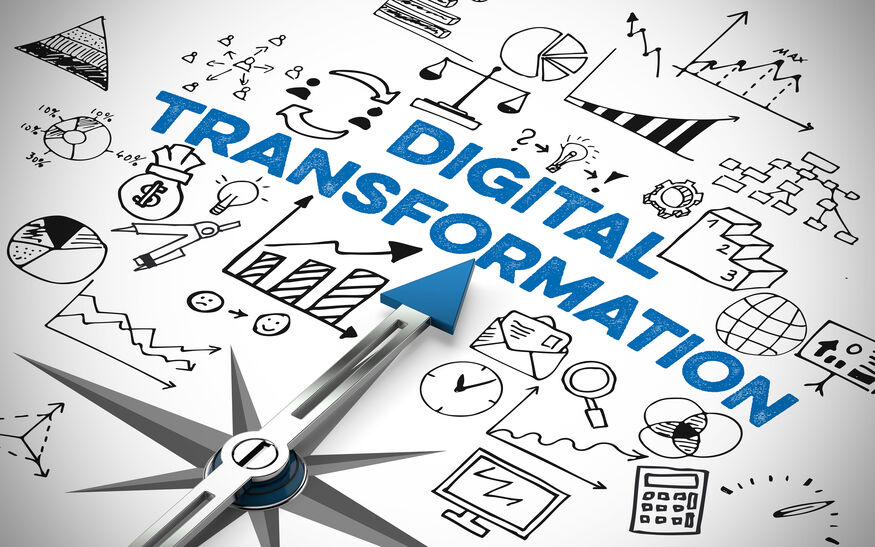Nov 01, 2021
An Encouragement of Introduction to Digital Transformation in Manufacturing
Part 1: Practical approaches for transformation
Digital transformation team

Summary
- The spread of technology has facilitated the connection of things to the Internet, enabling the utilization of a wide selection of data and causing ongoing structural changes to existing business models and supply chains.
- An effective long-term approach to take is the continuous refining of services and products and the exploring of new business models and activities, as it takes time for companies to familiarize themselves with digitalization initiatives and produce results.
- It is crucial to analyze the environment with a holistic view of the entire value chain, define the true challenges and needs within companies or departments, and then build detailed initiatives in collaboration with other organizations and companies.
Structural shifts and the future of manufacturing companies
Previously, manufacturing companies sought to cater to customers’ needs for products that can be used for a long time with stable performance. They strived for perfection in products while being eager to understand and please their customers, thereby realizing growth by continually boosting manufacturing capabilities with a focus on quality.
In recent years, customers’ needs are becoming more varied as technology advances. With customers’ values and expectations changing from owning to using through customer experience (CX), companies must deliver products and services that optimally accommodate a wide range of needs for individual customers rather than simply providing quality.
New business models are emerging in response to these changes in customer needs. Some of the new business models can address mass customization that operates with high production and sales volumes while delivering products and services that suit individual customers’ needs. Other models can provide firsthand experiences (connectedness), mainly through services (software) added to products (hardware).
We are likely to see more new business opportunities going forward and the industrial structure of manufacturing is expected to shift from a "pyramid" model centered on companies that produce and supply goods to customers to an "hourglass" model in which individual companies work directly with customers to engage in planning, design, and manufacturing together based on an open design philosophy and open technology. This trend will accelerate the data sharing across the whole value chain, and promote overall optimizations in the value chain that facilitate collaboration between any individual company and customers (Fig. 1: Structural shifts and the future of manufacturing companies).
This article overviews the areas and characteristics of DX (digital transformation) initiatives adopted by manufacturing companies, followed by introducing specific approaches to undertake digital transformations.

Fig. 1: Structural shifts and the future of manufacturing companies
* Created by QUNIE based on METI Chubu Bureau of Economy, Trade and Industry "The Future of Monodzukuri in 2040" (Future insight into 2040 Monodzukuri survey) (in Japanese). [1]
Reforms promoted by companies for DX
According to "DX Report 2" [2] published by the Ministry of Economy, Trade and Industry in December 2020, only 5% of Japanese companies have undertaken digital transformations in a companywide and sustainable manner. The other 95% have not pursued digital transformations at all or done so only with no particular direction (Fig. 2: Corporate DX initiatives, and actions to take). This report addresses concerns over the escalating gaps between winners and losers in digital competition, and suggests several actions to take based on the digital transformation status of companies.
First, let's look at the areas that companies need to engage in reform going forward for digital transformation, in addition to the areas in which companies are already doing so.

Fig. 2: Corporate DX initiatives, and actions to take
With regard to things we own or use, there has been a gradual replacement of analog forms with digital ones. The expansion of 5G networks and sensing technology has made it easier to provide Internet connectivity to a wide range of things, including even factory equipment and physical objects like vending machines. With regard to digitalized things, this has also increasingly facilitated the utilization of the data such things generate and business processes that provide them, as well as facilitating the use of digitalized things and the direct understanding regarding such usage.
This generated data is being utilized by digital disruptors arriving on the scene, who seek to upturn existing business models, and the structure of the supply chain is also undergoing reforms through digitalization.
There are four areas that must be considered for companies which strive to transform their business and achieve corporate transformation by leveraging technologies (Fig. 3: Reforms promoted by companies for digital transformation).
The first area is internal operational reform initiatives. In the face of a harsh market landscape for existing products where changes in demand cannot be foreseen, efforts in this area involve using the power of technology to streamline operations, reduce costs, and boost productivity in order to increase profits.
The second area is initiatives to further refine internal operations and businesses, such as utilizing digital technologies to make products and services more intelligent in themselves and increasing touch points with customers and markets to build digitally connected operations. These efforts serve to meet expectations created from using or owning products and services, while also boosting performance and functionality in a timely manner in order that companies can differentiate themselves from competitors and expand business.
The third area is initiatives to branch out into new businesses, in addition to existing operations and businesses, by creating touch points with end users, suppliers, and other parties that until now had limited direct contact with customers, thereby expanding business both upstream and downstream in the supply chain. Companies that are distant from end consumers, such as material and component manufacturers, are also continually working to understand customer needs as they improve product functionality and promote reforms in existing operations, thereby facilitating efforts in functional expansion and product development. Furthermore, equipment manufacturers are extending their scope of operations and connect data across boundaries to reach the manufacturers that install their products, thereby letting such manufacturers roll out new services for detecting product defects in the manufacturing process. As such, business model reforms are becoming increasingly more crucial towards corporate value enhancements in the medium to long term.
The fourth area is initiatives to build new businesses. The key for future business continuity may be found in ambidextrous management that constantly considers refining operations, services, and products without being swayed by the market environment for existing businesses, while also exploring new business models and activity models in parallel.

Fig. 3: Reforms promoted by companies for digital transformation
Classification of themes based on DX initiatives in business
We conducted ongoing surveys and analysis regarding case studies of digital transformation initiatives in business, summarized the essence of what is needed to promote digitalization, and defined six types of digital transformation for business reforms using digital technology as shown below (Fig. 4: Classifying themes for initiatives based on companies engaging in DX).

Fig. 4: Classifying themes for initiatives based on companies engaging in DX
Some companies have already engaged in digitalizing their operations (1) and creating small-scale results to help reform themselves, while others have worked with digitalized operations to go one step further and digitalize decision-making in businesses and operations (3). Originally, digital utilization often involved initiatives for using and analyzing externally published information such as social media posts as well as internal system data. Based on the results of analysis, companies would gain new insight and improve their operations or draft new measures. Currently, information digitalization is accelerating even for information that is hard to digitalize, such as hand-written forms and reports, the insights of experienced individuals and other tacit knowledge, and even sounds and smells that indicate signs of abnormalities in manufacturing, along with the boosts achieved in the performance of sensors and transmission methods. Meanwhile, there are some companies that are going to launch digital transformation units and start promoting measures in the future, and some spearheading companies that engage in digital transformation as a means to realize reforms.
Based on this digital transformation classification, companies could start by looking at the current state of their businesses and what they are aiming for, and then analyze their unique strengths and core competencies in order to actively pursue initiatives, decision-making, and other actions to streamline internal operations and boost productivity. It is effective to build many small successes through these efforts and thereby accumulate digital strengths within companies. Following these actions, these small successes can be used as a springboard to carry out externally facing initiatives such as the digitalization of customer touch points and channels, products, and services. By creating digital results not only within themselves, but also alongside their customers and partners, companies can expand the scale of their digitalization efforts.
It can take two to three years for a company to become well versed in digitalization initiatives, to promote all initiatives in the digital transformation classification rather than just specific areas of it, and to generate effects. However, even if it takes time, we believe that taking the following step-by-step approach from a long-term perspective is effective: accelerate digitalization inside the company; reinforce customer touch points outside of the company; digitalize products and services (4) in the "refining" part of Fig. 4, and digitalize the value chain (5) in the "exploring" part of the figure.
Approach for DX initiatives
In this part, let's think about specific approaches companies can take to undertake digital transformations.
There are three phases (Fig. 5: Approach for DX initiatives). The first phase to digital transformation is predominantly working on idea creation and framework planning. The second is the value validation phase. This phase validates the business value of the framework and ideas planned in the previous phase, and the possibility that the goals can be achieved with realistic technological means in order to verify hypotheses. The third is the full-scale deployment phase that promotes reforms for business development and refinement by reviewing the results of small trials conducted during the verification of the hypotheses and making a specific plan to apply such reforms to the organization’s operations and business. Organizations that follow this approach can reduce anticipated risks related to efforts to achieve change, and deliver digital transformation ideas without any need for reworking or there being a sense of stagnation.
It is particularly important at the first stage of considerations to think in broad terms to make progress, rather than to avoid spending time on an intricately detailed digital transformation framework. Even if it is a rough idea, it is vital to think while moving forward, to focus on making progress, and to identify the challenges while holding discussions with the relevant stakeholders so as to gain a deeper understanding of what truly needs to be solved in the business and what is needed to reform operations and businesses.

Fig. 5: Approach for DX initiatives
Predicting trends based on relevant stakeholder changes and the ensuing impact
The goal of digitalization should be the transformation of businesses and corporations themselves, and it should be pursued with a long-term outlook. Though it may sound elementary, companies are advised to perform an environmental analysis on factors affecting their businesses in the first stage of considerations (the idea creation and framework planning phase) and identify the trends of relevant stakeholders.
When it comes to an environmental analysis of stakeholders, it is imperative to look over not only a company's own clients, suppliers, and other stakeholders with direct supply-and-demand relationships but also the upstream and downstream segments that make up the value chain in order to pay broader attention to the players that comprise the value chain and understand the changes in these players. This analysis is essential because players in the value chain may explore opportunities to enter competitors' businesses and operational fields, or new entrants outside the existing value chain could emerge. It is also crucial to recognize the threat that digitalization might replace the products and services provided by a company. The diagram below shows an effective framework for ascertaining changes in the stakeholders around a company (Fig. 6: Environmental change analysis framework).
Organizations that use this framework can think about the changes in customers, society, and stakeholders and the ensuing impact, and explore the possible future business opportunities, threats, and risks, as well as the potential for business reform. This provides an overview of how your businesses and operations will be reformed and what reforms will take place.

Fig. 6: Environmental change analysis framework
Story creation and solution sharing to actualize DX ideas
Let's think about specific steps for considerations to find out what challenges may exist in a department, what issues its members must address together, and what initiatives need to be taken in response to the environmental changes surrounding the company.
In order to generate value from digital transformation ideas selected as themes to be addressed, organizations tend to consider specific methods for utilizing digital technology and data. In fact, they should first consider defining to exactly whom, such as customers, employees, or the industry, the value will be provided through the business, and what challenges and needs those value recipients have.
For example, the challenge can be defined as follows: A small or medium-sized enterprise (the recipient) cannot maintain an internal information systems unit, but it needs to tackle a shortage of system operators and administrators and increase productivity among people working on-site, and the enterprise also seeks to realize new workstyles by utilizing and analyzing a broad range of data generated by the system (the challenges).
Once the issues have been identified, it is necessary to flesh out the details about the value the company can provide, its unique characteristics that other companies cannot imitate, the value and superiority to be created through digital transformation, and the basis for securing superiority. For example, the details could be specified as follows: instead of simply providing system operation services to accommodate new workstyles, take an approach to reform working methods with a one-stop solution that solves challenges based on an analysis of data generated from different workstyles as well as from system operation and management.
My experience shows that digital transformation initiatives cannot be achieved by an organization or group of technological experts alone; rather, such initiatives need to be promoted through co-creation and collaboration with other organizations. This inevitably makes digital transformation complex with a large number of stakeholders. As such, when describing digital transformation ideas, it is vital to interpret them as a story that depicts what the background and recognized challenges are regarding the digital transformation ideas or the theme for initiatives, what value relevant markets and target users can receive, and who will work to carry out the initiatives. It is also key to proceed while sharing methods to tackle challenges with the team members currently engaging in initiatives.
It is advisable to use the DX canvas shown below when sharing these details with a team. The DX canvas is a sheet for organizing and sharing digital transformation ideas, and it serves as a framework for condensing the effective areas for consideration into ten points when pushing the digital transformation theme forward (Fig. 7 DX canvas).
Using this framework clarifies how a company will reform businesses and operations, transform business models, distribution channels and operations, clarify what will be transformed, and thereby create and provide value from the digital transformation idea. Details on usage and the key points will be described in another article within this series.

Fig. 7 DX canvas
* The DX canvas was developed by QUNIE based on the Business Model Canvas
The DX canvas can be used to hold interviews with related parties, and gain insight from the opinions offered in these interviews. Rather than treating the symptoms of the surface-level problems, it is crucial to instead take a deep dive to consider why these problems are occurring and to draft a working hypothesis on the challenges in relation to the true cause. No company or department should forget to consider the degree of necessary transformation by studying the business plans, challenges, and themes for initiatives at competitors similar to itself that are in the same industry, and analyzing the threat to such company or department and its own advantages.
Conclusion
There are many cases of organizations that have not taken a first step towards digitalization. It is never too late to start working on something. Consider today as the first step for all your future efforts, and use the DX canvas and other frameworks to think about how to promote digital transformation in your department.
The next article of this series will explain the approach for implementing digital transformation based on case studies from manufacturing companies working on these initiatives.
- [1] METI Chubu Bureau of Economy, Trade and Industry (2016), "The Future of Monodzukuri in 2040 (Future insight into 2040 Monodzukuri survey)", https://www.chubu.meti.go.jp/b21jisedai/report/miraidosatsu/ (retrieved on October 18, 2021) * Japanese
- [2] Ministry of Economy, Trade and Industry (2020), "DX Report 2 (Interim Report)", https://www.meti.go.jp/press/2020/12/20201228004/20201228004-2.pdf (retrieved on October 18, 2021) * Japanese







